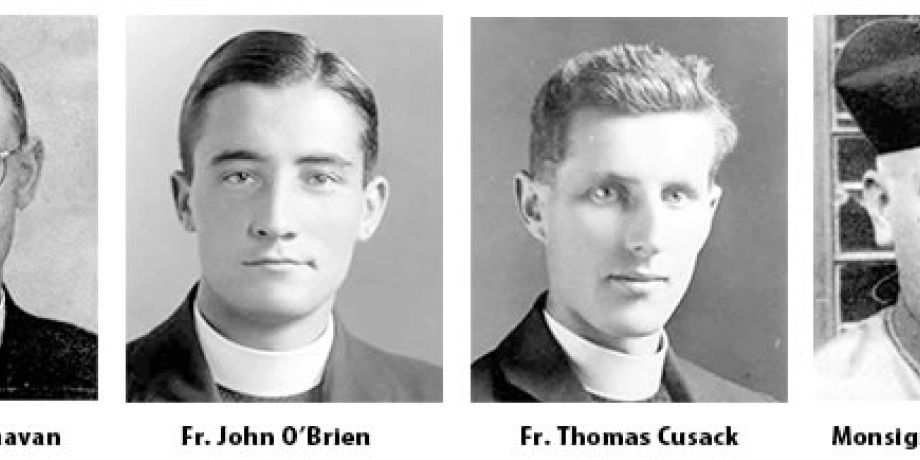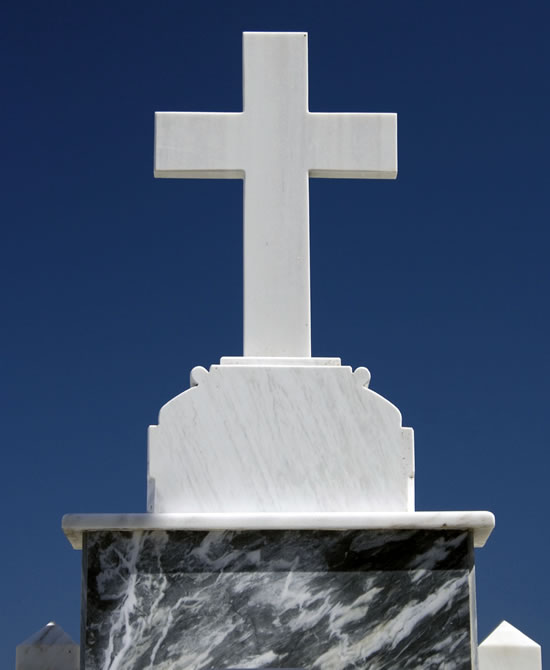
They Paid the Ultimate Price
Sanjeong Dong in Mokpo was both a parish and also the headquarters of the Columban mission in the southwest province of Chollanamdo in Korea in the 1940s. The pastor was Columban Fr. Tom Cusack and his assistant Columban Fr. John O'Brien. Monsignor Patrick Brennan was the superior, a big humorous man and a natural leader. Born in Chicago in 1901, he had originally been a Chicago diocesan priest until he joined the Columbans and came to Korea in 1937. Fr. Tom born in Liscannor, Ireland, in 1910, was ordained a Columban in 1934 and assigned to Korea. Both Brennan and Cusack had endured house arrest during the Japanese occupation and both were appointed to Mokpo in 1949. Fr. John O'Brien from Dunamon, Ireland, was born in 1917 and ordained a Columban in 1942. Unable to go to Korea due to the war, he volunteered as a military chaplain and saw service in Egypt and North Africa. He arrived in Korea in 1949. His brother Vincent was also a Columban assigned to the Philippines.

On July 17, 1950, an official from the American Consulate in Daegu had called at the Mokpo parish to warn Monsignor Brennan to leave with all his personnel because the United Nations (U.N.) forces would not be able to defend Mokpo. At a meeting of the priests that evening Monsignor Brennan stated that he was staying since, "It goes with the job." Later Harold Henry, a young priest present at that meeting, was to write that "there was silence in the room" after Brennan had spoken! Fr. Tom Cusack also stated he would stay. "I would not be able to live with myself if I left and the Catholics were killed," he said in a message sent to his mother through fellow Columban Fr. Michael O'Connor. Fr. John O'Brien stated he would stay also. Monsignor Brennan then instructed all the younger men in nearby parishes and those doing language studies to take refuge in the city of Busan.
On July 24 the North Korean forces entered Mokpo. The three priests were arrested and transferred to jail in Kwangju City. An American soldier, Alexander Makarounis, who shared the same cell as the Columbans, gave an account published in the Columban magazine, The Far East, September 1951. He told how the priests shared their blankets, lifted the spirits of the other prisoners, and often sang "Far Away Places," the 1948 Bing Crosby hit. On August 26, all were ordered to travel to Seoul. However the convoy was attacked near the city of Daejeon and the three Columbans were jailed in Daejeon along with thousands of others. The "valuable prisoners," i.e. missionaries and high officials, were billeted in the Franciscan monastery in Daejeon. The North Korean forces made this monastery their temporary headquarters and each time there was an air raid by U.N. forces the Western prisoners were ordered to the roof to be used as human shields. A woman, who was in a neighboring cell at that time, later testified that when they heard a prisoner being interrogated about Catholics in Daejeon "the three foreign priests went down on their knees and prayed throughout the night for that prisoner."
Towards the latter half of September the North Koreans had to abandon Daejeon due to the advancing U.N. forces. They executed all the prisoners during the period of September 24-26. The bodies of those in the monastery were dumped into a deep well in the grounds. In 1952 the well was emptied, the bodies cremated and the remaining ashes and bones were buried in a large grave on a nearby hill. In 1996 Daejeon city decided to develop the whole area. Family members of the dead were notified, and in their presence the grave was opened, the bones exhumed and each family took some of the bones to bury privately.
A local Catholic historian, who knew that three missionaries had been among those massacred, also attended the ceremony and took some of the bones in memory of the priests who died. Placing the remains into an urn, he erected a little shrine in his own garden to their memory. In 2006 the urn was transferred to a new memorial erected by Daejeon diocese in honor of the martyrs at the Catholic graveyard.

Today the names of Columban priests Patrick Brennan, Thomas Cusack and John O'Brien' are on the list of the 81 modern day martyrs in Korea, and the Church is promoting their beatification. In the face of death they elected to stay with their people and paid the ultimate price.
The Life of Frank Canavan
Columban Fr. Frank Canavan was born in 1915 in Headford, Galway Ireland, the eighth child in a family of nine. His older brother Liam was a priest in Sydney Archdiocese until his death in 1968. Frank joined the Columbans in 1934, and his parish priest Fr. Andy Moran in a letter of recommendation to the Columbans noted that Frank was "not of the robust kind or very strong…. is quiet, and conducts himself well, steadfast I should say very tenacious and persevering." He ended the letter with the rather prophetic words "his piety and character will pull him through where strong men would fail."
Ordained in 1940, but unable to go overseas due to World War II, he worked at Kinvara parish in the diocese of Galway until July 1948 when he was appointed to Jungrim Dong parish in Chuncheon City, Korea. His immediate task was to learn the language, get to know the culture and parish life. In letters to home he described visiting families and taking off one's shoes, sitting on the floor, etc. In one letter to his mother in June 1949 he made reference to the danger of a Russian invasion writing "it has been decided that the priests in Korea will remain in their posts, if anything happens and that is the only course to adopt." In that same letter he jokes with his mother about becoming a martyr and suggests that she could profit by cutting up his old coat and selling the strips as relics!! He seemed to have been very conscious of that possibility because in another letter to his sister Margaret he made a pun on his Korean name, Fr. Sohn, saying "Now that I am Sohn (sown) in Korea, I hope I will bear good fruit."
On Sunday, June 25, 1950, in Chuncheon the sound of gunfire was heard. There were regular skirmishes in the border area between the two parts of Korea but this time it seemed to be more serious. That afternoon Columban Fr. Philip Crosbie arrived from his parish at Hongchon to discuss the situation. That same evening the American adviser to the South Korean forces in the province of Kangwondo, came to advise the priests to flee. Fr. Tom Quinlan, the superior, stated he was staying but suggested to Frank that he leave, pointing out that that Frank was still a language student with no official pastoral responsibility. Frank said, "I want to stay." Fr. Phil Crosbie later wrote how Fr. Frank called him aside to talk. He had decided to stay – his reason for consulting Fr. Phil had been to confirm his decision. Fr. Phil wrote "And so he stayed. As I trudged back to Hongchon that day the image that had flickered in and out of my mind of a small man, with a smile in his eyes and peace in his heart, turning his face to a gathering storm."
Over the next week as their church was destroyed by shells, Frs. Tom and Frank spent their time trying to put our fires. On July 2 both were arrested by North Korean soldiers, transferred to Seoul and then to an internment camp in the north of the country. On October 31, 700 prisoners were ordered to march out and so began the infamous "Death March" over mountains in freezing weather where prisoners had to sleep in the open with no adequate dress or food. They marched 100 miles in nine days during which some 98 people died. Fr. Frank had contacted pneumonia during the march, and on December 4 and he told his colleague Fr. Tom that, "I will be having my Christmas dinner in Heaven." He died on December 6, 1950, the Feast Day of St. Nicholas, patron saint of Galway Diocese to whom he had a great devotion, and was buried where he died. Monsignor Quinlan later wrote "Frank Canavan could not be called a robust man, but in Chuncheon under fire he displayed heroic courage and on the long march helped the sick and the old who could not keep up with others. No words of mine could sufficiently extol his priestly virtues." (The Far East, August 1953). The words of the parish priest of Headford in 1934, "his piety and character will pull him through where strong men would fail" were so true!
Today a granite Celtic Cross with his name stands over an empty grave in the burial plot behind the cathedral in Chuncheon. Revered as a martyr because he choose to stay with the people and lost his life, that empty grave lies beside the graves of his three Columban martyr confreres Tony Collier, Patrick Reilly and Jim Maginn. Every Sunday throughout the diocese at the beginning of Mass the people offer a prayer for the beatification of the Columban Martyrs.
Columban Fr. Donal O'Keefe lives and works in South Korea.